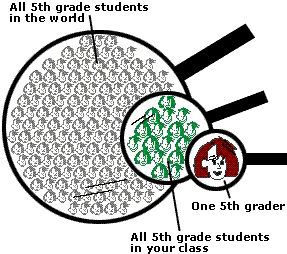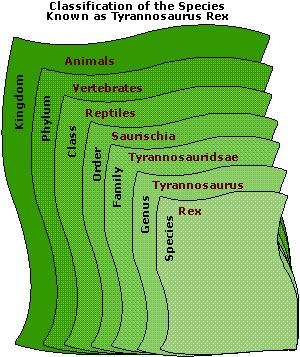|
Classification
Classification
is a technique we all use to organize our knowledge of people, places,
and things. We usually put different individual objects into classes
based on their similarities. For example, think about one student,
say, a 5th grader in your school. That student is a member of a
group of students that all share several similarities: they all
have the same 5th grade teacher in the same room at the same time.
We can classify this group of students into a single "class."
This class of 5th graders is also part of a much larger group: all
of the 5th grade students in the world.

Living
organisms are classified according to
visible physical similarities. All individual
organisms that appear the same (inside
and outside) and can interbreed to produce
offspring that can also interbreed are
classified as a species. Different species
are grouped by their similarities into
a "genus." Different genera
(plural of genus) are grouped by their
similarities into a family, and so on
as follows:
Species
are grouped into Genera,
which are grouped into Families,
which are grouped into Orders,
which are grouped into Classes,
which are grouped into Phyla,
which are grouped into Kingdoms.
All
living organisms on Earth can be grouped
into five kingdoms: Prokaryotes (single-celled
organisms lacking a nucleus, like bacteria),
Eukaryotes (single celled organisms
with a nucleus, like algae), Fungi (including
mushrooms), Plants, and Animals.
Paleontologists look
carefully at similarities in fossils to place extinct organisms
like dinosaurs into this classification system. Here is how one
well-known species of dinosaur is classified.

|











